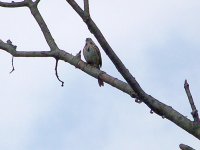My wife has heard this bird for several mornings now while I'm at work so I haven't heard it. Anyway, she says it makes four notes, which (she says) sounds like the first four notes of Beethoven's Fifth. She said it is very loud and sharp - not a low level twittering. I did some internet searching and the best I could find was the White-Breasted Wood Wren but its territory doesn't seem to be any farther north than central Mexico. We live in southern Arizona, USA. Any suggestions?
Last edited:





